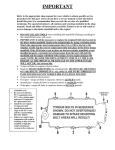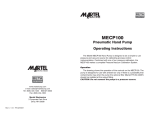Download View the Manual - Instrumentation.com
Transcript
WARRANTY Martel Electronics Corporation warrants the MECP500 pneumatic pump against defects in materials and workmanship for a period of twelve (12) months after date of sale. An invoice may be required as proof of purchase for warranty claims. Damage due to contamination or other misuse is not covered under this warranty. If any product is to be returned, a “Return Material Authorization” number may be obtained by calling our Customer Service Department toll free at 1-800-821-0023 in the US or Canada or +1-603-434-8179 outside the US. Access our RMA Form by using www.martelcorp.com, under Customer Service. MECP500 Pneumatic Hand Pump Operating Instructions The MECP500 Pneumatic Hand Pump is a compact, lightweight, portable, hand-operated pressure and vacuum pump. When a digital calibrator is added the unit can be used to calibrate or check pressure measuring devices in the field. No external power or high pressure bottles are required. The MECP500 is completely assembled and ready to connect to the pressure device to be calibrated. Calibration is quick and simple since the pump is taken directly to the pressure device. This pneumatic pump provides a source of air pressure, 0-500 psig (600 psi max.), or vacuum, 0-28" Hg. 1. Isolate the device to be calibrated. CAUTION: Do not connect to high pressure sources. Safe operating procedures must be exercised to avoid personal injury and damage to the calibration system. 2. Connect the pump and calibrator to the pressure device to be calibrated. Make sure the connection is pressure tight and be certain to use Teflon tape to prevent leakage. 3. Turn the knurled knob on the needle valve clockwise to close. NOTE: Hand tighten only to prevent damage to the valve seat. www.martelcorp.com e-mail: [email protected] Tel: (603) 434-1433 800-821-0023 Fax: (603) 434-1653 Martel Electronics 3 Corporate Park Dr. Derry, NH 03038 Rev D 10/09 P/N 0280257 4. Using a small screwdriver, set the shuttle valve to "pressure or vacuum". Note that "P" and "V" are stamped on the sides of the pump body. 5. Squeeze the handles until the desired or approximate pressure is obtained. Additional force is required as the pressure is increased. 6. The pressure can be decreased with the needle valve. 7. The pressure can be "fine tuned" with the vernier knob. To increase pressure, turn the vernier knob clockwise. Turning the vernier knob counterclockwise will decrease pressure. NOTE: The vacuum reading increases when the vernier knob is turned counterclockwise. 8. When the calibration procedure is completed, bleed the pressure before disconnecting the unit. CAUTION: To prevent personal injury, the pressure must be reduced to zero before disconnecting any element of the system. 9. Store the unit in a carrying case or other safe location. Pump Valve Assembly Cleaning Instructions Occasionally, the MECP500 may not work properly due to dirt or other contamination of the internal valve assembly. Use the following procedure for cleaning the valve assembly. If this procedure does not fix the problem, a repair kit (part number 1010043) may be ordered. 1. Using a small screwdriver, remove the 2 valve retention caps located on opposite sides of the pump below the pressure/vacuum switch. 2. After the caps have been removed, gently remove the spring and oring assembly. 3. Set aside the valve assemblies in a safe area and clean out the valve body using a cotton swab soaked in IPA (isopropyl alcohol). 4. Repeat the process several times using a new cotton swab each time until there is no remaining evidence of contamination or dirt. 5. Operate the pump handles several times and recheck for contamination. 6. Clean the o-ring assembly and the o-ring on the retention caps with IPA and inspect the o-rings closely for any damage or excessive wear. Replacements are included in the repair kit, if needed. 7. Inspect the springs for wear or loss of tension. They should be approximately 8.6 mm long in the relaxed state. If shorter, they may not provide sufficient sealing tension. Replace if needed. 8. Once all parts have been cleaned and inspected, reinstall the o-ring and spring assembly into the valve body. 9. Reinstall the retention caps and gently tighten each cap. 10. Seal the output port and operate the pump to at least 50% of capacity. 11. Release the pressure and repeat several times to ensure that the orings seat properly. To prevent damage use a wrench to hold the pump body when attaching a gauge or fitting








